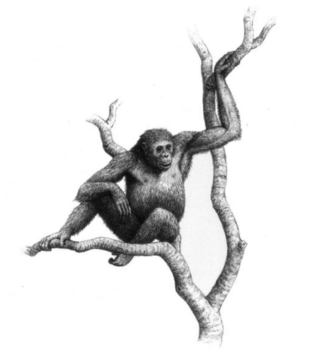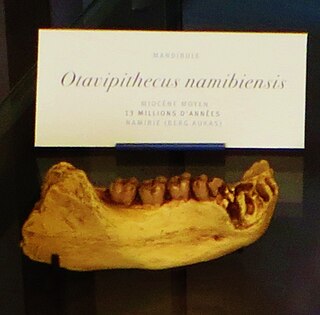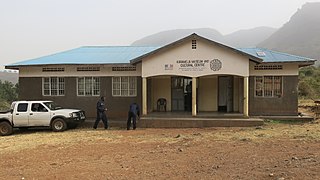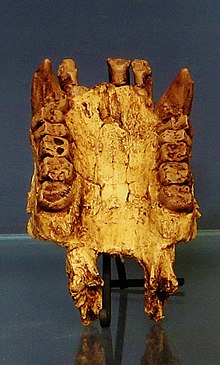
Apes are a clade of Old World simians native to sub-Saharan Africa and Southeast Asia, which together with its sister group Cercopithecidae form the catarrhine clade, cladistically making them monkeys. Apes do not have tails due to a mutation of the TBXT gene. In traditional and non-scientific use, the term ape can include tailless primates taxonomically considered Cercopithecidae, and is thus not equivalent to the scientific taxon Hominoidea. There are two extant branches of the superfamily Hominoidea: the gibbons, or lesser apes; and the hominids, or great apes.

Pierolapithecus catalaunicus is an extinct species of primate which lived around 12.5-13 million years ago during the Miocene in what is now Hostalets de Pierola, Catalonia, Spain. Some researchers believe that it is a candidate for common ancestor to the great ape clade, or is at least closer than any previous fossil discovery. Others suggest it being a pongine, or a dryopith. On 16 October 2023, scientists reported the facial reconstruction of the great ape.

Proconsul is an extinct genus of primates that existed from 21 to 17 million years ago during the Miocene epoch. Fossil remains are present in Eastern Africa including Kenya and Uganda. Four species have been classified to date: P. africanus, P. gitongai, P. major and P. meswae. The four species differ mainly in body size. Environmental reconstructions for the Early Miocene Proconsul sites are still tentative and range from forested environments to more open, arid grasslands.

Proconsul major, an extinct primate of the genus Proconsul, was possibly the ancestor of Afropithecus and showed hominid characteristics. It occurred during the early Miocene and was roughly, the size of a gorilla. The species previously referred to as Ugandapithecus major is now considered to be a synonym of Proconsul major. Prior to 2000 it was known as Proconsul major and some argue against the renaming.

Afropithecus is a genus of Miocene hominoid with the sole species Afropithecus turkanensis, it was excavated from a small site near Lake Turkana called Kalodirr in northern Kenya in 1986 and named by Richard Leakey and Meave Leakey. The estimated age of Afropithecus is between 16 and 18 million years old, which was determined with radiometric dating techniques and the geological studies conducted by Broschetto and Brown from the University of Utah. In total there are 46 recovered specimens from Kalodirr relating to Afropithecus consisting of cranial, mandible, dentition and post-cranial remains. The type specimen of Afropithecus turkanensis is KNM-WK 16999.

Ouranopithecus is a genus of extinct Eurasian great ape represented by two species, Ouranopithecus macedoniensis, a late Miocene hominoid from Greece and Ouranopithecus turkae, also from the late Miocene of Turkey.

Proconsulidae is an early family of primates that lived during the Miocene epoch in Kenya, and was restricted to Africa. Members of the family have a mixture of Old World monkey and ape characteristics, so the placement in the ape superfamily Hominoidea is tentative; some scientists place Proconsulidae outside of Hominoidea in a separately superfamily Proconsuloidea, before the split of the apes and Old World monkeys.
David Pilbeam is the Henry Ford II Professor of the Social Sciences at Harvard University and curator of paleoanthropology at the Peabody Museum of Archaeology and Ethnology. He is a member of the National Academy of Sciences. He received his Ph.D. from Yale University.

Samburupithecus is an extinct primate that lived in Kenya during the middle to late Miocene. The one species in this genus, Samburupithecus kiptalami, is known only from a maxilla fragment dated to 9.5 million years ago discovered in 1982 and formally described by Ishida & Pickford 1997. The type specimen KNM-SH 8531 was discovered by the Joint Japan-Kenya Expedition at the SH22 fossil site in the Samburu District, a locality where several other researchers found no ape fossils.

The Hominidae, whose members are known as the great apes or hominids, are a taxonomic family of primates that includes eight extant species in four genera: Pongo ; Gorilla ; Pan ; and Homo, of which only modern humans remain.
Kamoyapithecus was a primate that lived in Africa during the late Oligocene period, about 24.2-27.5 million years ago. First found in 1948 as part of a University of California, Berkeley expedition, it was at first thought to be under a form of Proconsul by C.T. Madden in 1980, but after a re-examination by Meave Leakey and associates later, the fossils were moved under a new genus Kamoyapithecus, named after the renowned fossil finder Kamoya Kimeu. The genus is represented by only one species, K. hamiltoni.

Saadanius is a genus of fossil primates dating to the Oligocene that is closely related to the common ancestor of the Old World monkeys and apes, collectively known as catarrhines. It is represented by a single species, Saadanius hijazensis, which is known only from a single partial skull tentatively dated between 29 and 28 million years ago. It was discovered in 2009 in western Saudi Arabia near Mecca and was first described in 2010 after comparison with both living and fossil catarrhines.

Nacholapithecus kerioi was an ape that lived 14-15 million years ago during the Middle Miocene. Fossils have been found in the Nachola formation in northern Kenya. The only member of the genus Nacholapithecus, it is thought to be a key genus in early hominid evolution. Similar in body plan to Proconsul, it had a long vertebral column with six lumbar vertebrae, no tail, a narrow torso, large upper limbs with mobile shoulder joints, and long feet.

Hispanopithecus is a genus of apes that inhabited Europe during the Miocene epoch. It was first identified in a 1944 paper by J. F. Villalta and M. Crusafont in Notas y Comunicaciones del Instituto Geologico y Minero de España. Anthropologists disagree as to whether Hispanopithecus belongs to the subfamily Ponginae or Homininae.

Anapithecus is a late Miocene primate known from fossil locations in Hungary and Austria. Many Anapithecus fossils come from the site of Rudabánya, in northern Hungary, where Anapithecus lived alongside the ape Rudapithecus. The only species in the genus, Anapithecus hernyaki, is named after Gabor Hernyák, chief geologist of the Iron Ore Works of Rudabánya.
The phylogenetic split of Hominidae into the subfamilies Homininae and Ponginae is dated to the middle Miocene, roughly 18 to 14 million years ago. This split is also referenced as the "orangutan–human last common ancestor" by Jeffrey H. Schwartz, professor of anthropology at the University of Pittsburgh School of Arts and Sciences, and John Grehan, director of science at the Buffalo Museum.

Ekembo is an early ape (hominoid) genus found in 17- to 20-million-year-old sediments from the Miocene epoch. Specimens have been found at sites around the ancient Kisingiri volcano in Kenya on Rusinga Island and Mfangano Island in Lake Victoria. The name Ekembo is Suba for "ape" or "monkey".

Otavipithecus namibiensis is an extinct species of ape from the Miocene of Namibia. The fossils were discovered at the Berg Aukas mines in the foothills of the Otavi mountains, hence the generic name. The species was described in 1992 by Glenn Conroy and colleagues, and was at the time the only non-hominin fossil ape known from southern Africa. The scientists noted that the surrounding area of the discovered specimen included fauna dated at "about 13 ± 1 Myr". The fossils consist of part of the lower jawbone with molars, a partial frontal bone, a heavily damaged ulna, one vertebra and a partial finger bone.
Kapi is an extinct primate genus that lived in northern India about 13.8 to 12.5 million years ago during the Miocene. The only species, K. ramnagarensis, was described in 2020 and is known from a complete lower molar. The fossil was discovered in 2015 from Ramnagar, a town in Jammu and Kashmir, for which the species name was created. Though originally identified as member of the gibbons and popularised in the news as the oldest gibbon, it was later reassessed as those of pliopithecoid, a group of extinct Old World monkeys.

Karamoja Regional Museum is a public museum in Moroto Town run under the Department of Museums and Monuments in the Ministry of Tourism, Wildlife and Antiquities of Uganda. It also serves as a cultural center where cultural heritage in form of objects is showcased for people to access and appreciate the cultural heritage of the Karamoja sub-region.



















